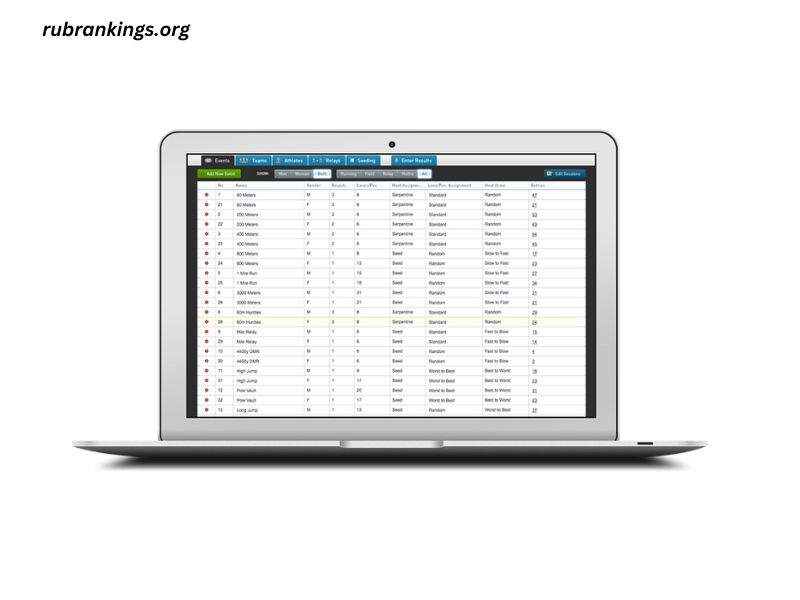Track and field events are a popular sporting activity that brings together athletes from various backgrounds to compete in a wide range of events. Whether you’re participating as an athlete, a coach, or a spectator, understanding the order of events in a track meet is essential for making the most out of the experience. The schedule, or order of events, provides a structure that ensures the meet runs smoothly and efficiently.
In this article, we’ll break down the typical order of events in a track meet, providing you with an overview of the various disciplines that make up a track meet, including sprints, distance races, relays, field events, and more.
What is a Track Meet?
Before we dive into the specifics of the order of events, let’s take a quick look at what a track meet entails. A track meet is a competition where athletes perform in various track and field events, typically hosted by schools, clubs, or organizations. The events are divided into two main categories: track events and field events.
Track events include races run on the track, such as sprints, middle-distance, and long-distance events. Field events, on the other hand, involve jumping or throwing, such as the long jump, high jump, pole vault, shot put, and discus throw.
A track meet can last anywhere from a few hours to a full day, depending on the number of events and participants. To keep everything organized, there is a specific order in which events are held.
Order of Events in a Track Meet
The order of events in a track meet can vary depending on the type of competition (e.g., high school, college, professional) and the specific regulations governing that event. However, the general structure remains relatively consistent across most meets. Below, we’ll outline a typical order of events, dividing them into track events and field events.
1. Track Events (Sprints)
Sprints are some of the most exciting and fast-paced events in a track meet. They test an athlete’s explosive speed and acceleration, often lasting less than a minute. The sprints are typically scheduled early in the meet to keep the energy high and the crowd engaged.
- 60m/100m Dash: In most meets, the 100-meter dash (or its indoor counterpart, the 60-meter dash) is one of the first events. It’s a straight sprint down the track, with competitors aiming to complete the race in the fastest time.
- 200m Dash: The 200-meter dash is slightly longer than the 100m but still considered a sprint. It involves running half the track, often with a curve. Athletes must maintain a high level of speed throughout the entire race.
- 400m Dash: The 400-meter dash is the longest of the sprint events. This event requires a combination of speed and endurance as athletes must complete a full lap of the track without slowing down significantly.
2. Middle-Distance Events
Middle-distance races are slightly longer than sprints but still demand a strong combination of speed and endurance. These races typically fall in the middle of a track meet schedule.
- 800m Run: The 800-meter race is a two-lap event that often challenges athletes to pace themselves. Runners start fast but must conserve energy to maintain speed until the final stretch.
- 1500m Run: The 1500-meter race, also known as the “metric mile,” is a middle-distance event that requires both speed and endurance. This race typically involves multiple laps and is often seen as a test of an athlete’s stamina and strategy.
3. Long-Distance Events
Long-distance races are typically scheduled later in a track meet to allow athletes to fully recover after their sprint and middle-distance races. These events are designed to test an athlete’s endurance, pacing, and mental fortitude.
- 5000m Run: The 5000-meter race is a long-distance event that requires athletes to maintain a steady pace over 12.5 laps. This event often takes place in the later stages of a meet and can sometimes be held under the lights in evening events.
- 10,000m Run: The 10,000-meter race is one of the longest events in track and field. Athletes in this race must have tremendous endurance, as they are required to complete 25 laps around the track.
4. Relay Events
Relays are team-based events where multiple athletes compete together in a race. Each member of the team runs a specific leg of the race, passing the baton to the next runner. Relays often occur in the middle to latter stages of the meet.
- 4x100m Relay: The 4×100 meter relay is a fast-paced team event where four athletes each run 100 meters. This race is a combination of speed, precision in baton exchanges, and teamwork.
- 4x400m Relay: The 4×400 meter relay is the final event of many track meets, and it often serves as a climactic finish to the competition. Each runner completes one lap of the track, for a total of four laps by the team.
5. Field Events (Jumping and Throwing)
Field events test athletes’ strength, technique, and skill in various disciplines like jumping and throwing. These events are typically held simultaneously with track races, though there are also field event-only competitions.
- Long Jump: In the long jump, athletes sprint down a runway and leap into a sandpit. Their goal is to jump as far as possible while maintaining proper technique.
- High Jump: The high jump is a jumping event where athletes attempt to clear a horizontal bar set at a specific height. Each jumper has three attempts to clear the bar without knocking it off its stand.
- Pole Vault: The pole vault is an exciting and challenging event where athletes use a pole to propel themselves over a high bar. The pole vault combines strength, agility, and technique.
- Shot Put: In the shot put, athletes throw a heavy ball (the shot) as far as possible within a designated sector. Throwers must use proper technique to maximize distance.
- Discus Throw: The discus throw involves throwing a heavy disc as far as possible within a marked area. Like the shot put, it requires strength, precision, and technique.
- Javelin Throw: In the javelin throw, athletes throw a long spear-like object as far as possible. This event requires a combination of strength, speed, and technique.
6. Combined Events
Some track meets also feature combined events, which involve multiple disciplines and challenge athletes to perform well across several areas. These events typically have their own distinct schedule within the meet.
- Decathlon (Men’s): The decathlon is a two-day event with ten different disciplines, including sprints, distance races, jumps, and throws. It’s a true test of an athlete’s versatility and endurance.
- Heptathlon (Women’s): The heptathlon is similar to the decathlon, but it includes seven events. Women compete in various track and field events over the course of two days.
Conclusion
The order of events in a track meet is crucial to the overall flow and success of the competition. By understanding the typical schedule of track and field events, athletes and spectators can better prepare for the meet and enjoy the various races and field events that take place.
In general, track meets follow a structured order, beginning with the sprints and progressing through the middle- and long-distance races, followed by the relay events, field events, and possibly combined events. This schedule ensures that athletes have enough time to rest between events, while also maintaining a high level of excitement and engagement for spectators.
Whether you’re an athlete competing for victory or a fan cheering on your favorite competitors, understanding the order of events in a track meet can enhance your overall experience, making it easier to follow along with the action and appreciate the skill and dedication of all participants.



